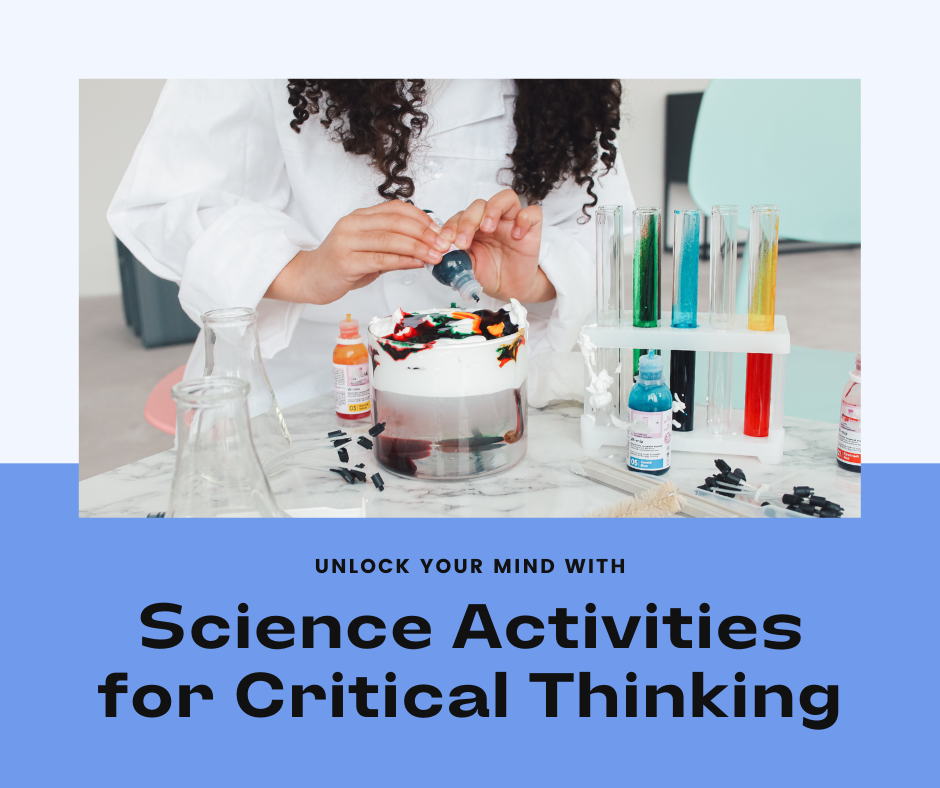Are you ready for exciting science activities? Science and engineering are puzzles. They’re like adventures. You need curiosity to dive into details. As NGSS says, it’s all about getting into the heart of things.
…students cannot fully understand scientific and engineering ideas without engaging in the practices of inquiry and the discourses by which such ideas are developed and refined. At the same time, they cannot learn or show competence in practices except in the context of specific content. (NRC Framework, 2012, p. 218)
To understand science, you need to dive in. Roll up your sleeves! Get your hands dirty with activities. So, let’s start now! Here are some of my favorite science activities for critical thinking.
Why Teach Critical Thinking?
Wondering about the importance of teaching critical thinking through analysis, engineering, and exploration? It helps students:
- Understand Better: Grasp topics more easily.
- Solve Problems: Improve at tackling challenges and making wise decisions.
- Think Independently: Develop self-thinking, understanding, and openness to new ideas.
- Communicate Effectively: Enhance speaking skills through collaborative science.
- Prepare for the Future: Get ready for life’s challenges.
Each reason is crucial. Together, they highlight the need for teaching critical thinking. It profoundly impacts learners. Now, let’s explore those activities.
Activity #1: Fact Strainer Exercise
Need fast activities for your daughter? Check out Julie Bogart’s “Raising Critical Thinkers. A Parent’s Guide to Growing Wise Kids in the Digital Age.” It’s full of challenges for parents and students.
An example? The “Fact Strainer” exercise in Chapter 2. Kids sift facts from stories. They find facts in news articles about the same event. They highlight where these facts appear, like at the beginning, middle, or end. Then, they list the facts on paper in the order they found them.
Discuss why facts are placed where they are. What was the author’s goal? The exercise teaches spotting facts first. It helps ignore the writer’s bias. Bogart’s book has even more ideas along these lines.
Activity #2: Science Buddies Activities
Imagine having a buddy who’s always up for some cool science experiments. Science Buddies has a treasure trove of fun activities. These will make you say, “Whoa, I didn’t know science could be this awesome!” Featured activities include:
- Build a Paper Roller Coaster
- Build a Balloon Car
- Turn Milk into Plastic
- Secret Messages with Invisible Ink!
- Make Ice Cream in a Bag
- Make a Lemon Volcano
- And more!
Activity #3: Education Possible
Education Possible has a great list of Fun and Engaging Science Activities for middle school students. They prove science can be exciting! In this collection, you will find activities like making volcanoes erupt, chemical reactions, and how to create rainbow colors. With these science activities, you are in for a blast (not the explosive kind, of course!). These are split up into life science, physical science. miscellaneous, and more.
Activity #4: 55 Clever 7th Grade Science Fair Projects and Classroom Experiments
Think your students are too young? These projects work for any grade. You might become a star science fair facilitator. Here are my top ten favorite activities from this article:
- Balloon-Powered Car: Build a balloon-driven car. Test its speed.
- Geodesic Dome: Use newspaper and tape to construct a sturdy dome.
- Solar Oven: Create an oven that cooks with the sun. Learn about energy.
- Spherify Drinks: Turn drinks into tiny balls. A chemistry experiment.
- Purify Water with Charcoal: See how charcoal filters water.
- Wave Machine: Make a simple machine to understand waves.
- Water Clock: Build an ancient-style clock. Watch how it measures time.
- DIY Barometer: Construct a barometer. Predict weather changes.
- Hydraulic Power: Explore hydraulics. Create your hydraulic device.
- Grow and Experiment with Crystals: Learn about crystals. Grow them yourself.
Given those cool activities, which would you try first?
Activity #5: Little Bins for Little Hands Science Experiments
Get ready to find wonders with everyday items. Additional science activities on this site feature chemistry, earth sciences, physics, and STEM. You and your students can create amazing things. From their website, here’s a supermarket supply list:
Mason jars, plastic bottles, baking soda, salt, vinegar, zip-top bags, rubber bands, glue, hydrogen peroxide, food coloring (optional), and other common items. These make science easy for everyone.
Using such materials brings science closer to students. Involve your whole school in collecting these supplies.
But wait, there’s more!
Explore over 60 science activities and videos! It’s like a science museum in your hands. Don’t miss this chance to turn learning into an adventure! Which activity will you try out first?

